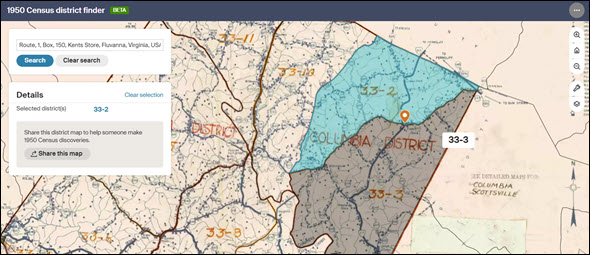Ancestry launches ED finder tool
It’s an impressive piece of work — and it’s going to save the bacon of a lot of otherwise frustrated genealogists (including The Legal Genealogist, for sure) in just a few days.
Ancestry has launched an enumeration district finder for the 1950 census.
Yeah, that census. The one that’s being released in — squeeeee! — just three days.
It’s called the 1950 Census district finder — and it works.
It pulled up the suburban location where my parents were soon to buy a home in New Jersey — and both of the ones where they might actually have been living at the time. (I think they were actually living in Golden, Colorado, but they may have already moved to Aurora by then.)
It pulled up the urban location where I hope to find a key relative in Chicago.
It even got really close to a rural location in Virginia where the address was nothing more than a rural route and box number — and where I sure hope to find my grandparents.

Here’s the issue:
When that 1950 census becomes available to the public on Friday, April 1, it won’t have anything approaching a full name index. The National Archives and many of the vendors are working to release a machine-read name index, and that will be an enormously helpful benefit to start with.
But we all know the limits of machine-reading of handwritten documents. There are going to be names that are mangled and names that are missing. And before we whine about that, remember: we didn’t have any kind of index at all when the 1940 census was released 10 years ago. If we wanted to find somebody in that census before the first crowdsourced indexes were available months later, we read through a set of census pages line by line.
So the initial machine index will help.
But we’re still going to end up looking for folks by reading through a set of census pages line by line.
The issue is finding the right set of index pages.
We want to narrow this down well below the state or county or town level. We need to identify the exact enumeration district if we can.
Now there are wonderful tools for this. Steve Morse’s One-Step Pages for the US Census (1790-1950) are fabulous. But that set of tools doesn’t work quite so well in rural areas — and there is nothing quite as easy as entering an address in a search box, and watching the results pop up on the screen.
No, it’s not perfect. If my grandparents are found on that census, it’ll be in Virginia enumeration district 33-3, not 33-2. (The blue area in the map above is where Ancestry suggests that I look; the grey area is where that address actually was located.)
But being able to get those maps up just by entering the address makes it a lot easier to know where to start.
So don’t expect much out of me for a few days starting just after midnight Eastern time on Friday.
I got people to find in the census. Two siblings, two parents, two grandparents, a great grandparent, and a crap-ton of aunts, uncles and cousins, to be precise.
And maybe I’ll even find a few of them faster, thanks to Ancestry’s cool new tool, the 1950 Census district finder.
Cite/link to this post: Judy G. Russell, “Getting ready for Friday,” The Legal Genealogist (https://www.legalgenealogist.com/blog : posted 29 March 2022).



Judy, if you get too overwhelmed, I can actually tell you where my family lived in 1950- – -not the enumeration district, but the location and, after a conference with my sisters, maybe a rural address!!! Just sayin’.
More better, I’ll let you find them and send me the links!!! 🙂
For my addresses in Ohio, (some street addresses and some only townships), the results were wrong more than right. It pays to verify the address with the map so as not to be searching through whole EDs in the wrong part of the town or county.
Yep, always. As stated, the tool isn’t perfect.
It would be a good idea if people alive today would go back and figure out where they were for each census. In 1950, I was in a classroom in Grundy, VA. I am looking forward to seeing who my classmates were. 1940-50-60-70 and 1990, I was in one place for the census taking, but also moved the same year. Help your descendants.
Judy, you are always with the legal jargon- “crap-ton” HA HA.
Best of luck to everyone researching the 1950 census…
Is that Imperial or Metric? Isn’t Metric 2.2 times the Imperial?
🙂 🙂 🙂
Could you include the the direct link for the Census district finder? (It didn’t appear on my Ancestry homepage so I had to go digging for it.) https://www.ancestry.com/discoveryui-content/district-map/62308 Thank you!
Interesting. It’s on my Ancestry homepage twice.
Is Ancestry’s Census District Finder available on Ancestry Library Edition?
No. The 1950 Census District Finder is not available on institutional accounts. However, it is a free tool and the 1950 census will be available for free. So, anyone who has ever had an Ancestry account (ever had a subscription, ever taken a DNA test, ever built a tree or done a free trial) just needs to use the same login to access it. Anyone who’s never had an account can create a free, registered guest account for access.